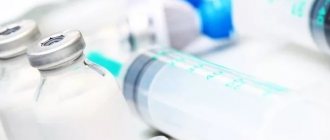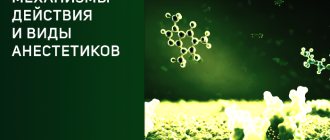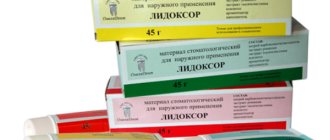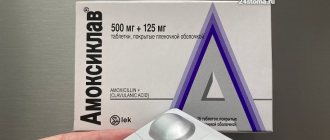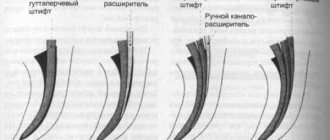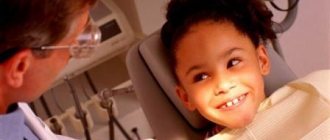Ultracaine D-S forte. Carpules 1.7 ml
Active substance:
– articaine hydrochloride 40 mg/ml. Note, 40 milligrams in one milliliter! This means that in one carpool there are 68 mg. This is actually very important. Why - see below.
– epinephrine hydrochloride 12 mcg/ml. Again, note that we are talking about micrograms (millionths of a gram) per milliliter. It turns out that the carpul contains 20.4 mcg of epinephrine hydrochloride. Well. or 17 mcg, in terms of pure adrenaline.
Inactive substance:
– sodium disulfite (sodium metabisulfite) – 0.5 mg/ml (0.85 mg/carpule)
– sodium chloride (saline solution) – 1 mg/ml (1.7 mg/carpule)
– water – everything else.
Other information:
According to a number of studies (A. I. Marakhova, M. A. Zhuravleva et al., 2015), the drug Ultracaine D-S forte, according to high-precision chromatography, contains about 0.047% of impurities, which the authors attribute to articaine derivatives.
The pH of the Ultracain D-S forte solution is 3.960. Moreover, pH fluctuations are allowed within the range of 3.0-5.0
Origin:
Sanofi-Aventis Deutchland GmbH, Germany.
Articaine or ultracaine, which is better? It doesn't hurt! Modern methods of anesthesia
We are publishing an article by Natalya Lvovna Mayorova, a dentist and therapist, head of the therapeutic department of the Dentalika clinic.
Pain relievers used in modern dental practice can work wonders. After receiving an anesthetic injection, the patient does not feel any pain or even particularly unpleasant sensations. To ensure that the injection itself is painless, before the procedure the doctor “freezes” the injection site with a special preparation with a delicious smell of cherry, lemon, or apple.
Local anesthesia is the main method of pain relief used in dental practice. With local anesthesia, the patient remains fully conscious, and this allows the doctor to fully control the entire course of treatment, communicate with the patient, and monitor your reaction.
The quality of dental interventions depends on the results the doctor obtained during local anesthesia. Therefore, achieving 100% pain relief is necessary not only for the patient, but also for the doctor, in order to carry out treatment calmly, slowly, and efficiently. Hence the following requirements for local anesthetics:
- they must have a strong analgesic effect, easily penetrate into tissues and remain there for as long as possible;
- have low toxicity, causing a minimum number of both general and local complications
Based on these wishes, we chose several widely used drugs:
- Ultracaine DS forte (4% articaine, adrenaline 1:100,000);
- Ultracaine DS (4% articaine, adrenaline 1:200,000);
- Scandonest SVC (3% mepivacaine; without vasoconstrictors - adrenaline).
Now in more detail about their action.
Ultracain DS
The analgesic basis of the first two drugs is ARTICAINE (amide anesthetic from the thiophene series), an antispasmodic - lowers blood pressure. It is characterized by rapid action - anesthesia occurs in 0.5-3 minutes. Articaine is 2 times stronger than lidocaine and 6 times stronger than novocaine (anesthetics of previous generations), less toxic, relatively quickly eliminated from the body. Its half-life is, on average, 22 minutes, that is, all traces of the drug disintegrate in 44 minutes and are then completely eliminated from the body. Has high penetrating ability. It is distinguished by high purity of the solution. Allergic reactions to articaine are very rare - one in one hundred thousand injections; the use of articaine, according to studies, is safe in 99.4% of cases. They also contain a vasoconstrictor (a substance that causes constriction of blood vessels and a decrease in blood flow in them) - adrenaline. The use of a vasoconstrictor continues and enhances anesthesia. The drug also contains antioxidants (sulfites) - substances that prevent the oxidation of adrenaline.
Ubistezin forte
Active substance:
– articaine hydrochloride 40 mg/ml , which corresponds to 68 mg in one carpule.
– epinephrine hydrochloride 12 mcg/ml , which corresponds to 17 mcg of adrenaline in the capsule.
Inactive substance:
– sodium sulfite – 0.6 mg/ml (1.02 mg in carpool)
– sodium chloride – 1.125 mg/ml (1.913 mg in carpool)
– water – everything else.
Other information:
Stabilization of Ubistezin by pH is carried out with a buffer solution of hydrochloric acid and sodium hydroxide, which are obviously present in the form of impurities, but for some reason are not indicated in the analytical passport.
The pH of the Ubistezin forte solution is 3.90. The pH of the solution may vary from 3.6 to 4.4.
Origin:
3M Deutchland GmbH, Germany
===========================
In general, what can I say about these two drugs... the difference between them, as you can see, is very small. So insignificant that you have to be a completely anesthetic sommelier or a drug addicted chemist to notice it. Someone here argued that the whole difference is in the pH value, but it is also very, very insignificant.
So why do doctors, and very well-known and authoritative ones, claim that Ubistezin works worse than Ultracaine? And why is there a legend among dentists that Ultracain is more effective and safe than Ubistezin?
We decided to look into this.
Types of anesthesia before tooth extraction
In most cases, local anesthesia is sufficient for any dental procedures. Typically, this is one or more injections into the gums. Some clinics perform three-stage anesthesia, which completely eliminates pain. In this case, an anesthetic gel is first applied, then a short injection is given, and after some time a sufficient dose of anesthetic is administered. Sometimes it also becomes necessary to perform a similar operation under general anesthesia. What anesthesia for tooth extraction is required in each specific case is determined by the doctor in accordance with individual characteristics.
Most often, local anesthesia is sufficient. Such anesthesia relieves the patient 100% of pain. Only tactile sensitivity is preserved, which can also cause discomfort, but not severe. There are several types of local anesthesia.
- Application anesthesia relieves pain only with superficial intervention. It is usually used before an injection to make insertion of the needle painless. Sometimes it is indicated when removing baby teeth in children. This anesthesia is carried out using a gel or spray based on lidocaine or benzocaine. They are applied to the gums.
- Infiltration anesthesia is the most common method. In this case, pain relief during tooth extraction is administered by injection. Usually you need 2-3 injections on one side and the other of the diseased tooth.
- Conduction anesthesia involves injecting an anesthetic into the area of the nerve. After this, the entire area innervated by it loses sensitivity. It is usually used only on the lower jaw.
- Trunk anesthesia is used in serious cases or when the patient is hypersensitive. In this case, the medicine is injected into the base of the skull.
In addition, sometimes a method such as sedation is also used. This is the administration of intramuscular or intravenous sedatives. They calm the patient, increase the pain threshold, and relax.
Anesthesia experts.
A quick survey of doctors (113 people in total) showed that the number of fans of one or another anesthetic is approximately equal. Almost 98.9% of doctors explain their fanaticism by habit, but there are no clear answers to the question “why did you choose this particular anesthetic?” We have not received. In addition, to the question “what is the difference between Ubistezin and Ultracaine D-S forte?” we received the following responses:
In my opinion, any fanaticism is bad and can affect the results of the study, so we invited independent experts who have never performed anesthesia in their lives. This means that their opinion is absolutely unbiased and can be trusted.
These are members and employees of Tseleevo Golf and Polo Club. With HCP penis length not exceeding 28.0 cm.
Reviews about pain relief in dentistry
Nowadays dental treatment has become much more comfortable than before. Pain is usually not felt even when removed. At the same time, many patients note that they received effective pain relief with the help of regular Lidocaine. But there are also those who cannot tolerate this drug. And those who have been injected with modern anesthetics note that they have a better analgesic effect. There are many positive reviews about the drug "Ultracain", patients note that they do not feel anything even during a complex operation.
Category: Tooth extraction Published by Mister stomatolog
Research method.
In general, we asked our experts to make a drive (long shot) with two carpules - Ubistezin and Ultracain. Tests were carried out with a Titleist Practice ball and different drivers at a side wind speed of 0.5-1 m/s. A total of 10 injections of drive anesthetic were made from each type of carpule.
Ultracain® D-S (Ultracain® DS)
The drug is intended for use in the oral cavity and can only be injected into tissues where there is no inflammation.
It is impossible to inject into inflamed tissues.
The drug cannot be administered intravenously. In order to avoid accidental release of the drug into the blood vessels, an aspiration test (in two stages) should always be performed before its administration.
The main systemic reactions that may develop as a result of accidental intravascular administration of the drug can be avoided by following the injection technique: after an aspiration test, slowly inject 0.1-0.2 ml of the drug, then, no earlier than 20-30 seconds later, slowly inject the remaining dose of the drug. The injection pressure should correspond to the sensitivity of the tissue.
For anesthesia during uncomplicated extraction of teeth in the upper jaw in the absence of inflammation, it is usually sufficient to create a depot of the drug Ultracain ® D-S in the area of the transitional fold by introducing it into the submucosa from the vestibular side (1.7 ml of the drug per tooth). In rare cases, an additional injection of 1 ml to 1.7 ml may be required to achieve complete anesthesia. In most cases, this eliminates the need for a painful palatal injection. When removing several adjacent teeth, the number of injections can usually be limited.
For anesthesia for incisions and sutures in the palate to create a palatal depot, about 0.1 ml of the drug is required for each injection.
In the case of removal of mandibular premolars in the absence of inflammation, mandibular anesthesia can be dispensed with, since infiltration anesthesia provided by an injection of 1.7 ml per tooth is usually sufficient. If in this way it was not possible to achieve the desired effect, an additional injection of 1-1.7 ml of anesthetic should be performed into the submucosa in the area of the transitional fold of the mandible on the vestibular side. If in this case it was not possible to achieve complete anesthesia, it is necessary to conduct a conduction block of the mandibular nerve.
When treating cavities and grinding teeth for crowns, with the exception of the lower molars, depending on the volume and duration of treatment, administration of the drug Ultracain ® D-S is indicated in the area of the transitional fold on the vestibular side in a dose of 0.5-1.7 ml per tooth.
When performing one treatment procedure, adults can be administered articaine in a dose of up to 7 mg per 1 kg of body weight. It was noted that patients tolerated doses up to 500 mg (corresponding to 12.5 ml of solution for injection) well.
For pediatric patients (over 4 years old), the minimum doses necessary to achieve adequate anesthesia should be used; the dose of Ultracaine ® D-S is selected depending on the age and body weight of the child, but the dose of articaine should not exceed 7 mg per 1 kg of body weight (0.175 ml/kg). The use of the drug in children under 1 year of age has not been studied.
For elderly patients and all patients with severe renal and hepatic insufficiency, it is possible to create increased plasma concentrations of articaine. For these patients, the minimum doses necessary to achieve a sufficient depth of anesthesia should be used.
Research results and discussion.
Based on the results of the study, experts made the following conclusions:
- Doctor Vasiliev, are you completely stoned there, or what? – in general, a correct judgment. Non-negotiable.
– what kind of granny is this anyway? – rather a question rather than a result.
– getting drive from an anesthetic carpule is strange, to say the least. Respected experts told me the same thing.
– the length of the drive does not depend in any way on the brand of anesthetic. The effectiveness of anesthesia, obviously, too.
Ubistezin
Ubistezin is a German drug that is produced. It contains the local anesthetic articaine and the hormone epinephrine (adrenaline), which has a vasoconstrictor effect. Vasoconstriction ensures a low degree of penetration of the drug into the blood and maximum effect at the site of use.
The drug has 2 release forms: with an epinephrine concentration of 1:200000 and 1:100000. The analgesic effect occurs within 1-3 minutes after administration. The duration of action is at least 75 minutes.
The drug is used only for anesthesia in dentistry (infiltration and conduction). It should not be administered intravenously or used in areas of inflammation.
Septanest
Septanest is an anesthetic that has been used in medical practice for quite some time. In addition to articaine and epinephrine, it contains auxiliary substances, which often cause complications of anesthesia in dentistry such as allergic reactions of patients. The drug is available in two dosage forms: with an epinephrine content of 1:100,000 and 1:200,000.
The effect of the drug appears after 1-3 minutes. Its duration is at least 45 minutes. It has good tissue tolerance and has a moderate vasoconstrictor effect.
Scandonest
What anesthesia in dentistry is suitable for patients with diabetes, thyroid diseases, an increased tendency to allergic reactions and patients with bronchial asthma? Scandonest is a drug that does not contain vasoconstrictor components or preservatives. Therefore, it is suitable for all patients at risk. For some, it is used with caution (during pregnancy, diseases of the liver, kidneys and cardiovascular system).
The anesthetic is produced on the basis of 3% mepivacaine. It provides fast, long-lasting and strong pain relief. Suitable for all types of local anesthesia.
Ultracaine
Ultracaine
– this is the best anesthesia in dentistry during pregnancy and for many diseases. It is based on articaine and is available in three forms: with a concentration of epinephrine 1:100000, 1:200000 and completely without epinephrine. The drug contains almost no preservatives. Lasts on average 2-3 hours. According to reviews from dentists and patients, ultracaine is the most potent among its analogues.
The cost of a carpule of any of the listed medications is approximately 30-50 rubles.
This article is for informational purposes only, please consult your doctor for details!
